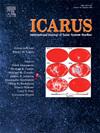1983年撞击土星C环的进一步回响
IF 2.5
2区 物理与天体物理
Q2 ASTRONOMY & ASTROPHYSICS
引用次数: 0
摘要
在2010年进行的低倾角卡西尼射电科学子系统(RSS)掩星观测中,发现了土星内C环(74,500-77,765公里)中波长约1公里的波纹模式,显示出周期性的脉动模式(Marouf et al., 2011)。最初被解释为类似于海德曼等人(2007年,2011年)在接近春分的卡西尼成像科学子系统(ISS)的C环和D环中发现的波长为m=1的~ 30公里垂直波纹,这些特征的短波长表明它们是从几个世纪前的两次撞击中演变而来的。然而,由于与这一模型存在重要的不一致之处,无法可靠地确定其来源。一项全面的搜索揭示了卡西尼号RSS、视觉和红外测绘光谱仪(VIMS)和紫外成像光谱仪(UVIS)在2008年至2017年期间观测到的掩星中对这种模式的额外探测,这些掩星显示,随着时间的推移,涟漪的波长显著减少,这表明它的起源比几个世纪前晚得多。我们将波纹结构中可见的明显节拍模式识别为m=0和m=2垂直模式的干涉,它们的振幅相似,但频率略有不同,随着时间的推移而演变,并以由环粒子的平均运动控制的速率缠绕,而不是由适用于m=1波纹的慢得多的节点速率控制。通过对观测到的两种模式随时间变化的波长的经验拟合和单个光学深度剖面的功率谱分析,我们证明了短波长的垂直波纹起源于产生环中较长波长的m=1周期结构的同一事件。我们推断撞击日期为UTC 1983年9月19.25±5.5天,考虑到环自重力对波纹的卷起率的貌似很小的贡献。掩星数据中没有对应m=0或m=2的径向模式,或m≥3的垂直模式的令人信服的特征,并且没有证据表明在77,765 km的轨道半径之外可检测到波纹结构。新识别模式的测量振幅Az0和Az2与环光学深度呈反相关关系。我们发现,在2008年至2017年间,这两种模态的振幅都显著下降。n体碰撞数值模拟提供了垂直和径向环黏度的约束,与观测到的模态振幅Az0和Az2的径向趋势及其随时间的变化相一致。假设有效粒径R=1 m,则推断的恢复系数ϵn ~ 0.5,对应的垂直和径向粘度νz = 1.6 cm2s−1和νr = 2.2 cm2s−1,半径为75,500 km。估计该地区m=0和m=2垂直模态的初始振幅是其2017年观测值的4 ~ 7倍。本文章由计算机程序翻译,如有差异,请以英文原文为准。
Further reverberations of the 1983 impact with Saturn’s C ring
A pattern of 1 km wavelength ripples exhibiting a periodic beating pattern in Saturn’s inner C ring (74,500–77,765 km) was detected in low-inclination Cassini Radio Science Subsystem (RSS) occultation observations made in 2010 (Marouf et al., 2011). Initially interpreted as analogous to the 30 km wavelength vertical corrugations with discovered in the C and D rings in near-equinox Cassini Imaging Science Subsystem (ISS) images by Hedman et al. (2007, 2011), the shorter wavelength of these features suggested that they had evolved from a pair of impacts several centuries ago. However, important inconsistencies with this model prevented a secure identification of their origin. A comprehensive search has revealed additional detections of this pattern in Cassini RSS, Visual and Infrared Mapping Spectrometer (VIMS) and Ultraviolet Imaging Spectrograph (UVIS) occultations observed between 2008 and 2017 that show a significant decrease in the wavelength of the ripples over time, suggesting a much more recent origin than centuries ago. We identify the conspicuous beat pattern visible in the ripple structure as the interference of and vertical modes of similar amplitudes but slightly different frequencies, evolving over time and winding up at a rate governed by the mean motion of ring particles, rather than by the much slower node rate that is applicable to the corrugations. From empirical fits to the observed time-dependent wavelengths of the two modes and power spectral analysis of individual optical depth profiles, we demonstrate that the short-wavelength vertical corrugations originated from the same event that produced the longer-wavelength periodic structure in the rings. We infer an impact date of UTC 1983 Sep 19.25 ± 5.5 d, taking into account a plausibly small contribution of ring self-gravity to the windup rates of the corrugations. No convincing signatures of counterpart or radial modes, or of vertical modes with , are present in the occultation data, and no evidence of ripple structure is detectable beyond an orbital radius of 77,765 km. The measured amplitudes and of the newly-identified modes are anti-correlated with the ring optical depth. We detect a significant decrease in the amplitudes of both modes between 2008 and 2017. N-body numerical collisional simulations provide constraints on the vertical and radial ring viscosity that are compatible with the observed radial trend of mode amplitudes and and their variation with time. Assuming an effective particle size =1 m, the inferred coefficient of restitution , with corresponding vertical and radial viscosities νz = 1.6 and νr = 2.2 at a radius of 75,500 km. The initial amplitudes of the and vertical modes are estimated to be 4 to 7 times their observed values in 2017 in this region.
求助全文
通过发布文献求助,成功后即可免费获取论文全文。
去求助
来源期刊

Icarus
地学天文-天文与天体物理
CiteScore
6.30
自引率
18.80%
发文量
356
审稿时长
2-4 weeks
期刊介绍:
Icarus is devoted to the publication of original contributions in the field of Solar System studies. Manuscripts reporting the results of new research - observational, experimental, or theoretical - concerning the astronomy, geology, meteorology, physics, chemistry, biology, and other scientific aspects of our Solar System or extrasolar systems are welcome. The journal generally does not publish papers devoted exclusively to the Sun, the Earth, celestial mechanics, meteoritics, or astrophysics. Icarus does not publish papers that provide "improved" versions of Bode''s law, or other numerical relations, without a sound physical basis. Icarus does not publish meeting announcements or general notices. Reviews, historical papers, and manuscripts describing spacecraft instrumentation may be considered, but only with prior approval of the editor. An entire issue of the journal is occasionally devoted to a single subject, usually arising from a conference on the same topic. The language of publication is English. American or British usage is accepted, but not a mixture of these.
 求助内容:
求助内容: 应助结果提醒方式:
应助结果提醒方式:


